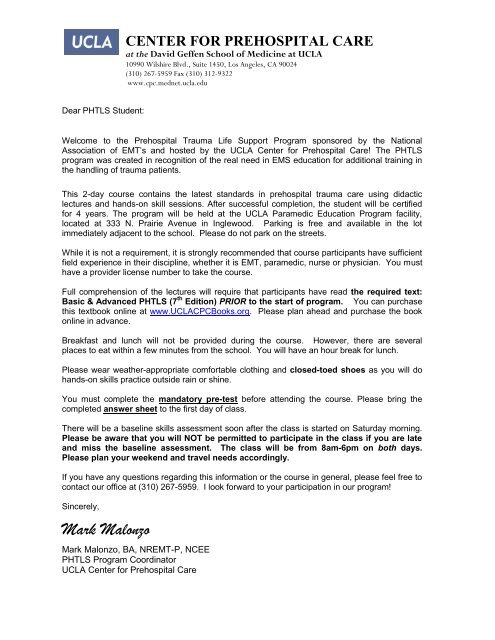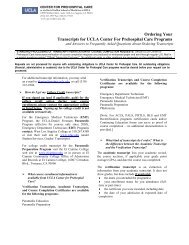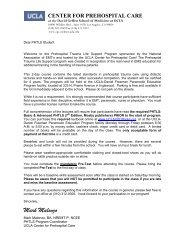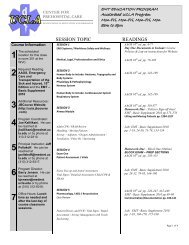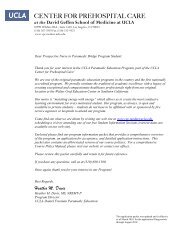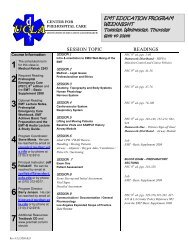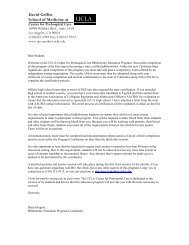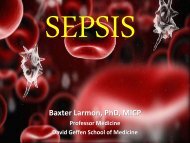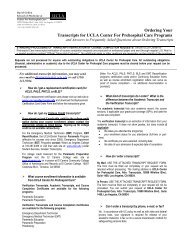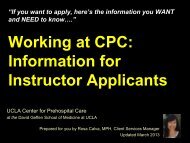PHTLS Pre-Test & Map (pdf) - UCLA Center for Prehospital Care
PHTLS Pre-Test & Map (pdf) - UCLA Center for Prehospital Care
PHTLS Pre-Test & Map (pdf) - UCLA Center for Prehospital Care
You also want an ePaper? Increase the reach of your titles
YUMPU automatically turns print PDFs into web optimized ePapers that Google loves.
CENTER FOR PREHOSPITAL CARE<br />
at the David Geffen School of Medicine at <strong>UCLA</strong><br />
10990 Wilshire Blvd., Suite 1450, Los Angeles, CA 90024<br />
(310) 267-5959 Fax (310) 312-9322<br />
www.cpc.mednet.ucla.edu<br />
Dear <strong>PHTLS</strong> Student:<br />
Welcome to the <strong>Pre</strong>hospital Trauma Life Support Program sponsored by the National<br />
Association of EMT’s and hosted by the <strong>UCLA</strong> <strong>Center</strong> <strong>for</strong> <strong>Pre</strong>hospital <strong>Care</strong>! The <strong>PHTLS</strong><br />
program was created in recognition of the real need in EMS education <strong>for</strong> additional training in<br />
the handling of trauma patients.<br />
This 2-day course contains the latest standards in prehospital trauma care using didactic<br />
lectures and hands-on skill sessions. After successful completion, the student will be certified<br />
<strong>for</strong> 4 years. The program will be held at the <strong>UCLA</strong> Paramedic Education Program facility,<br />
located at 333 N. Prairie Avenue in Inglewood. Parking is free and available in the lot<br />
immediately adjacent to the school. Please do not park on the streets.<br />
While it is not a requirement, it is strongly recommended that course participants have sufficient<br />
field experience in their discipline, whether it is EMT, paramedic, nurse or physician. You must<br />
have a provider license number to take the course.<br />
Full comprehension of the lectures will require that participants have read the required text:<br />
Basic & Advanced <strong>PHTLS</strong> (7 th Edition) PRIOR to the start of program. You can purchase<br />
this textbook online at www.<strong>UCLA</strong>CPCBooks.org. Please plan ahead and purchase the book<br />
online in advance.<br />
Breakfast and lunch will not be provided during the course. However, there are several<br />
places to eat within a few minutes from the school. You will have an hour break <strong>for</strong> lunch.<br />
Please wear weather-appropriate com<strong>for</strong>table clothing and closed-toed shoes as you will do<br />
hands-on skills practice outside rain or shine.<br />
You must complete the mandatory pre-test be<strong>for</strong>e attending the course. Please bring the<br />
completed answer sheet to the first day of class.<br />
There will be a baseline skills assessment soon after the class is started on Saturday morning.<br />
Please be aware that you will NOT be permitted to participate in the class if you are late<br />
and miss the baseline assessment. The class will be from 8am-6pm on both days.<br />
Please plan your weekend and travel needs accordingly.<br />
If you have any questions regarding this in<strong>for</strong>mation or the course in general, please feel free to<br />
contact our office at (310) 267-5959. I look <strong>for</strong>ward to your participation in our program!<br />
Sincerely,<br />
Mark Malonzo<br />
Mark Malonzo, BA, NREMT-P, NCEE<br />
<strong>PHTLS</strong> Program Coordinator<br />
<strong>UCLA</strong> <strong>Center</strong> <strong>for</strong> <strong>Pre</strong>hospital <strong>Care</strong>
<strong>PHTLS</strong><br />
7 th Edition<br />
<strong>Pre</strong>-<strong>Test</strong><br />
<strong>Pre</strong>-<strong>Test</strong><br />
Version 1.3
Instructions to Candidates<br />
This 25-question exam is designed to assess your<br />
base knowledge of trauma care. It is written <strong>for</strong> all<br />
levels of EMTs and prehospital providers. There are<br />
some questions that the correct answer may be an<br />
advanced procedure that the basic-level provider is<br />
unable to per<strong>for</strong>m due to system protocols or training<br />
levels. It is assumed that any provider who is taking<br />
the <strong>PHTLS</strong> course, regardless of level of training,<br />
will understand and recognize the need <strong>for</strong> an ALS<br />
procedure, even if they are not authorized to do so..<br />
To this end, the basic provider should select the ALS<br />
answer if appropriate and not deem it incorrect<br />
because the procedure cannot be per<strong>for</strong>med by a<br />
basic provider.<br />
Version 1.3 1
1) Your EMS unit is en route to the scene of an assault. Dispatch in<strong>for</strong>mation<br />
indicates law en<strong>for</strong>cement has not yet arrived on the scene. The safest approach to<br />
this situation is:<br />
A) Staging at the scene so that you can advise dispatch of the nature of the<br />
patient’s injuries<br />
B) Arriving on scene but staying inside the vehicle until law en<strong>for</strong>cement advises<br />
the scene is safe<br />
C) Staging at a safe location away from the scene until law en<strong>for</strong>cement advises<br />
the scene is safe<br />
D) Arriving on scene and initiating care, as long as bystanders confirm the<br />
assailant is no longer there<br />
2) Which is a sign of ventilatory inadequacy in a trauma patient?<br />
A) Equal breath sounds<br />
B) Ventilatory rate of 12<br />
C) Speaking in short bursts<br />
D) Sp0 2 of 95% on room air<br />
3) During the primary survey of a trauma patient, you note that the patient is agitated<br />
and confused and appears to have multiple injuries from an altercation. Of the<br />
following choices, your first treatment priority should be:<br />
A) Controlling all bleeding<br />
B) Establishing an intravenous line<br />
C) Correction of possible hypoxia<br />
D) Full immobilization to a backboard<br />
4) Which is the most common cause of upper airway obstruction in the trauma<br />
patient?<br />
A) Teeth<br />
B) Blood<br />
C) Tongue<br />
D) Vomitus<br />
5) Which is the most significant complication of prolonged suctioning of trauma<br />
patients?<br />
A) Hypoxia<br />
B) Bradypnea<br />
C) Bradycardia<br />
D) Hypercarbia<br />
Version 1.3 2
6) Which is the most important reason to maintain an open airway in the trauma<br />
patient?<br />
A) To prevent snoring respirations<br />
B) To prevent aspiration and pneumonia<br />
C) To prevent hypoxemia and hypercarbia<br />
D) To prevent the tongue from blocking the pharynx<br />
7) Your patient is a middle-aged male who crashed his motorcycle. He is<br />
unresponsive. After opening the airway using a modified jaw thrust, you note the<br />
patient has snoring respirations at a rate of 6. Auscultation reveals breath sounds<br />
are absent on the left side. The next intervention should be to:<br />
A) Insert an endotracheal tube<br />
B) Apply a nonrebreather mask<br />
C) Begin ventilation with a BVM<br />
D) Per<strong>for</strong>m a needle decompression<br />
8) Hypotension of unknown etiology in a trauma patient should be assumed to result<br />
from:<br />
A) Blood loss<br />
B) Spinal injury<br />
C) Cardiac tamponade<br />
D) Tension pneumothorax<br />
9) Hypotension in the healthy adult initially occurs with what percent of blood loss?<br />
A) Less than 15%<br />
B) 15% to 30%<br />
C) 31% to 40%<br />
D) More than 40%<br />
10) Medication used by trauma patients <strong>for</strong> preexisting conditions may cause which<br />
of the following?<br />
A) Herbal preparations may enhance blood clotting.<br />
B) Anti-inflammatory agents may enhance blood clotting.<br />
C) Beta blockers may prevent tachycardia with blood loss.<br />
D) Calcium channel blockers may slow the onset of shock.<br />
Version 1.3 3
11) Your patient is a 20-year-old male who struck his head on a teammate’s knee<br />
while diving to catch a football. He was not wearing a helmet. He demonstrates<br />
decerebrate posturing and has a GCS score of 4. His heart rate is 58, blood<br />
pressure is 180/102, and his left pupil is dilated. What is the best ventilation rate<br />
to use when managing this patient?<br />
A) 10 breaths per minute<br />
B) 20 breaths per minute<br />
C) 30 breaths per minute<br />
D) 35 breaths per minute<br />
12) The most common cause of injury in pediatric patients less than 10 years of age<br />
is:<br />
A) Falls<br />
B) Burns<br />
C) Penetrating injuries<br />
D) Motor vehicle collisions<br />
13. An 18-year-old female was struck by a car and has sustained an apparent left<br />
femur fracture. Communication with her is hampered because she only speaks a<br />
<strong>for</strong>eign language. Which finding, by itself, does not mandate immobilization of<br />
the cervical spine?<br />
A) Mechanism of injury<br />
B) Fracture of the femur<br />
C) Inability to communicate<br />
D) Tenderness over the cervical spine<br />
14) Referencing the Parkland <strong>for</strong>mula, what percent of the calculated IV volume<br />
should be administered in the first 8 hours following the injury?<br />
A) 10%<br />
B) 25%<br />
C) 33%<br />
D) 50%<br />
15) Specific signs of inhalation injury include:<br />
A) Burns<br />
B) Wheezing<br />
C) Tachycardia<br />
D) Hypotension<br />
Version 1.3 4
16) The preferred prehospital wound management <strong>for</strong> a patient with a 36% body<br />
surface area flame burn is:<br />
A) Elastic bandages<br />
B) Topical ointments<br />
C) Dry sterile dressings<br />
D) Cool moist dressings<br />
17) The most immediate life-threatening condition resulting from injury to solid<br />
abdominal organs is:<br />
A) Peritonitis<br />
B) Hemorrhage<br />
C) Multiple organ failure<br />
D) Acute respiratory failure<br />
18) You arrive at the scene of a motor vehicle collision in which a vehicle struck a<br />
tree. Which is the best indicator of potential injury?<br />
A) Height of the tree<br />
B) Mass of the vehicle<br />
C) Speed of the vehicle<br />
D) Circumference of the tree<br />
19) Which is the most important indicator of a serious injury in a victim of a shotgun<br />
wound?<br />
A) The position of the victim when shot with the gun<br />
B) The total weight of the projectile shot from the gun<br />
C) Distance between the victim and the gun when shot<br />
D) Velocity of the projectile leaving the gun when shot<br />
20) Which best describes an injury caused by shearing <strong>for</strong>ces?<br />
A) Liver damage due to a gunshot wound<br />
B) Aortic tear due to sudden deceleration<br />
C) Bilateral leg amputation due to pedestrian/train collision<br />
D) Pelvic fracture due to posterior displacement of the femur<br />
21) Bilateral femur fractures are most often associated with which type of motorcycle<br />
crash?<br />
A) Rear impact<br />
B) Angular impact<br />
C) Head-on impact<br />
D) Bike-road impact<br />
Version 1.3 5
22) Severe injuries should be suspected when a patient falls from a height of ______<br />
times his or her height or greater.<br />
A) two<br />
B) three<br />
C) four<br />
D) five<br />
23) Which is the preferred adjunct device <strong>for</strong> verifying placement of an endotracheal<br />
tube in a patient with a perfusing rhythm?<br />
A) Stethoscope<br />
B) Pulse oximeter<br />
C) Esophageal detector device<br />
D) End-tidal CO 2 monitoring (capnography)<br />
24) The target blood pressure <strong>for</strong> a trauma patient with suspected intraabdominal<br />
hemorrhage is:<br />
A) 60 – 70 mm Hg<br />
B) 80 – 90 mm Hg<br />
C) 100 – 110 mm Hg<br />
D) 120 – 130 mm Hg<br />
25) Which best explains the mechanism by which gas exchange is impaired in<br />
pulmonary contusion?<br />
A) Blood in the alveoli<br />
B) Collapse of the alveoli<br />
C) Compression of the lung tissue<br />
D) Partial occlusion of the bronchi<br />
Version 1.3 6
<strong>Pre</strong>-Hospital Trauma Life Support Provider Program<br />
Written Evaluation Answer Sheet<br />
Name:<br />
Date:<br />
Social Security Number: <strong>Pre</strong>-<strong>Test</strong> Post-<strong>Test</strong> <br />
1) A B C D<br />
2) A B C D<br />
3) A B C D<br />
4) A B C D<br />
5) A B C D<br />
6) A B C D<br />
7) A B C D<br />
8) A B C D<br />
9) A B C D<br />
10) A B C D<br />
11) A B C D<br />
12) A B C D<br />
13) A B C D<br />
14) A B C D<br />
15) A B C D<br />
16) A B C D<br />
17) A B C D<br />
18) A B C D<br />
19) A B C D<br />
20) A B C D<br />
21) A B C D<br />
22) A B C D<br />
23) A B C D<br />
24) A B C D<br />
25) A B C D<br />
26) A B C D<br />
27) A B C D<br />
28) A B C D<br />
29) A B C D<br />
30) A B C D<br />
31) A B C D<br />
32) A B C D<br />
33) A B C D<br />
34) A B C D<br />
35) A B C D<br />
36) A B C D<br />
37) A B C D<br />
38) A B C D<br />
39) A B C D<br />
40) A B C D<br />
41) A B C D<br />
42) A B C D<br />
43) A B C D<br />
44) A B C D<br />
45) A B C D<br />
46) A B C D<br />
47) A B C D<br />
48) A B C D<br />
49) A B C D<br />
50) A B C D<br />
5 th Edition December 2002
<strong>UCLA</strong> <strong>Center</strong> <strong>for</strong> <strong>Pre</strong>hospital <strong>Care</strong><br />
Directions to <strong>UCLA</strong>-Daniel Freeman<br />
<strong>UCLA</strong> - Daniel Freeman – 333 N. Prairie Avenue, Inglewood, CA 90301<br />
From the 405 North & 405 South<br />
Southbound – Take the San Diego Freeway SOUTH- exit Florence/ Manchester Ave. exit. Turn<br />
left onto Florence Ave. Turn right on Prairie Ave. (1.5 Miles). Turn right on Grace Ave.<br />
Northbound – Take the San Diego Freeway NORTH – exit Manchester Blvd. Exit. Turn right<br />
onto Manchester Blvd. Turn left onto Prairie Ave. (1.5 Miles) continue straight on Prairie Ave. to<br />
Grace Ave. turn left onto Grace Ave.<br />
Parking <strong>for</strong> <strong>UCLA</strong> Daniel Freeman's Paramedic School is located in the Physician parking area<br />
directly next to the school. The Physician parking area is the 3 rd drive way entrance to your left on<br />
Grace Street which can be access from Prairie Ave. There is no fee <strong>for</strong> parking in the Physicians<br />
parking lot.


